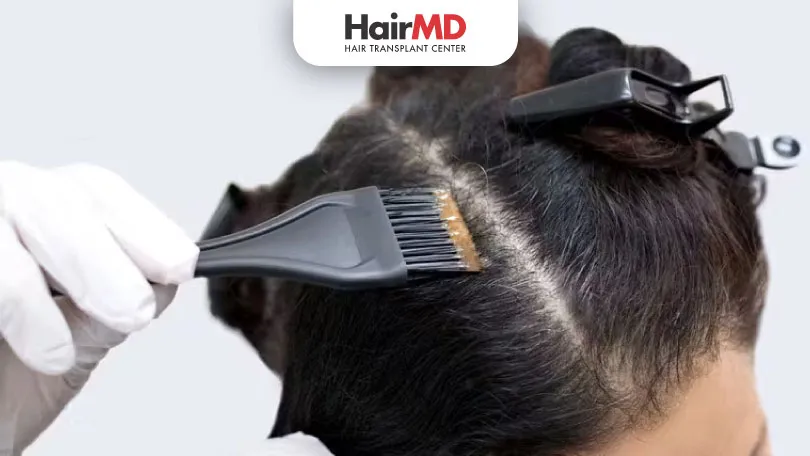
Coloring or dying the hair is a common practice, mostly taken up for cosmetic reasons like covering white or grey hair, changing to a color which could look more appealing or restoring the appearance of previously damaged hair. Does coloring/dying damage the hair? Does Hair Coloring Cause Thinning? Does hair dye cause hair loss? Most individuals who opt for hair coloring have questions like these, owing to the fear of chemicals in the hair dye leading to hair damage.
It is true that if the hair is exposed to harsh chemicals like the ones present in hair dyes and artificial hair coloring products, the hair may start thinning or falling out. However, is dying your hair bad for thinning hair, and if yes, then what is the safest hair dye for thinning hair? Let’s find out.
What’s covered in the article?
- Does Coloring Your Hair Lead To Thinning?
- How Much Hair Loss Is Normal After Bleaching?
- Conclusion
Does Coloring Your Hair Lead To Thinning?
- Coloring Hair doesn’t reach the follicles in your scalp, so it doesn’t directly cause hair loss. However, frequent hair coloring can weaken your hair, making it prone to breakage and thinning.
- Hair coloring often contain chemicals like ammonia and hydrogen peroxide. Ammonia opens the hair cuticle, allowing peroxide to change the hair color. This process makes hair more porous and weaker, leading to breakage.
- Peroxide not only lightens hair but also strips essential proteins from the hair shaft, weakening the strands over time. This process can lead to increased hair fragility, breakage, and eventually contribute to noticeable hair thinning, especially with frequent use.
- Bleaching hair to a much lighter shade than its original color can significantly weaken the hair structure, as the bleaching process strips away natural pigments and moisture. This can lead to dryness, brittleness, and in some cases, hair breakage or falling out, especially if the hair is already damaged or over-processed.
- Hair dye ingredients can loosen hair that’s already in the shedding phase (telogen phase). This is worsened by combing or rubbing the hair during the coloring process.
- Some people may experience allergic reactions to hair dye, causing scalp irritation, itching, and hair fall. A common allergen in hair dyes is Paraphenylenediamine (PPD), which can cause rashes and hair loss.
How to Safely Dye Thinning Hair:
- Use semi-permanent hair dyes that don’t contain harsh chemicals like ammonia or alcohol.
- Avoid coloring your hair too often—once a month with ammonia-free dyes is a safer option.
- Always follow package instructions and use high-quality hair dyes.
- Deep condition your hair after coloring to restore moisture and reduce damage.
- Perform a patch test on your skin before using any new hair dye to check for allergic reactions.
Being gentle with your hair and choosing milder products can help minimize damage and hair thinning from coloring.
How Much Hair Loss Is Normal After Bleaching?
Yes, it’s normal to lose some hair after bleaching. In general, a healthy person loses 50-100 strands of hair daily, which isn’t a cause for concern. However, bleaching can lead to more hair loss because it damages the hair. The chemicals in bleach break down the outer keratin layer, weaken the hair, and strip away proteins and fatty acids. This makes hair thinner, dry, brittle, and prone to breakage and split ends.
Why does bleaching cause hair loss?
- Bleaching weakens hair by breaking down its proteins and fatty acids.
- It dries out the hair, reducing elasticity, leading to breakage.
- Excessive peroxide use or bleaching too often (less than 6-8 weeks apart) can damage hair severely.
- Allergic reactions to bleaching agents or underlying health conditions can also cause significant hair loss.
How to reduce bleaching-related hair loss:
- Use hair vitamins (consult a Dermatologist first).
- Add more proteins and essential fatty acids to your diet.
- Use quality shampoo, conditioner, and hair serum.
- Protect your hair from the sun.
- Apply nourishing hair masks.
- Massage your scalp regularly.
- Leave at least 6-8 weeks between bleaching sessions.
If your hair is falling out in clumps or feels extremely weak after bleaching, it could mean too much peroxide was used or the bleaching process wasn’t safe. In such cases, it’s best to consult a dermatologist.
For personalized advice on hair loss or damage from bleaching, visit HairMD, a leading hair transplant and dermatology clinic in Pune. Their team of experts can guide you on maintaining healthy hair and recommend safe treatments. Remember, consulting a dermatologist is the best way to address concerns like thinning hair or selecting the safest hair dye.
Do You Know?
Nearly 250 Patients Visit HairMD
Everyday For Various Hair Concerns?
(Your journey to healthier and fuller hair starts here!)
Meet Our Dermatologists
Conclusion
While coloring your hair can cause damage and thinning if not done carefully, using high-quality products and proper aftercare can minimize the risks. Consulting a professional stylist and following a healthy hair care routine can help maintain the strength and thickness of your hair, even with regular coloring.
Further Reading
PRP Therapy for Hair Loss in Pune 2026 – Cost, Effectiveness & Results
Complete guide to PRP therapy for hair loss in Pune 2026. Learn about costs (₹3,000-15,000/session), 70-80% success rates, procedure details, and how it compares to FUE and medications.
Ethical Hair Transplant Practices – Why HairMD Pune Is Trusted?
Discover what ethical hair transplant practices look like and why patients trust HairMD Pune. Learn to spot red flags, verify surgeon credentials, and make informed decisions for your hair restoration journey
Low-Cost Hair Transplant Clinics in Pune – Risks & Warnings
Discover why ultra-low-cost hair transplants in Pune are dangerous. Learn red flags, true costs, and how to verify surgeon credentials before risking your scalp health.
Top Hair Growth Treatments for Women: Your Ultimate Guide
Find effective hair regrowth treatments for women. Explore solutions like PRP, medications, and more to combat hair loss with expert advice from HairMD.










